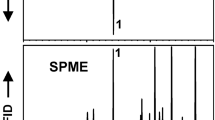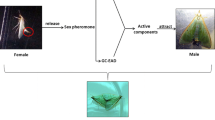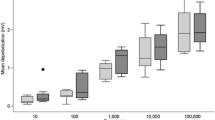Abstract
MaleSpodoptera littoralis stimulated by a mixture ofS. littoralis female sex pheromone with a positional isomer and by the pheromone alone, gave greatly amplified electroantennograms (EAGs) when the antennae were connected in series. The technique is described and examples are given of its use in screening extracts for EAG activity. Dose-response curves obtained with this technique are presented and discussed. Through biological amplification, EAG discrimination between the pheromones was increased.
Similar content being viewed by others
References
Kehat, M., Greenberg, S., andTamaki, Y. 1976. Field evaluation of the synthetic sex pheromone as an attractant for males of the cotton leafworm,Spodoptera littoralis (Boisd.) in Israel.Appl. Entomol. Zool. 11:45–52.
Navon, A., andKeren, S. 1980. Rearing the Egyptian cotton leafworm.Spodoptera littoralis, on a practical calcium-alginate diet.Phytoparasitica 8(3):in press.
Nesbitt, B.F., Beevor, P.S., Cole, R.A., Lester, R., andPoppi, R.G. 1973. Sex pheromones of two Noctuid moths.Nature 244:208–209.
Payne, T.L. 1975. Bark beetle olfactors. III Antennal olfactory responsiveness ofDendroctonus frontalis Zimmerman andD. brevicomis Le Conte (Coleoptera: Scolytidae) to aggregation pheromones and host tree terpene hydrocarbons.J. Chem. Ecol. 1:233–242.
Priesner, E. 1979. Specificity studies on pheromone receptors of noctuid and tortricid Lepidoptera, pp. 57–71,in F.J. Ritter (ed.). Chemical Ecology: Odour Communication in Animals. Elsevier/North Holland Biomedical Press, Amsterdam.
Roelofs, W.L. 1977. The scope and limitations of the electroantennogram technique in identifying pheromone components, pp. 147–165,in N.R. McFarlane (ed.). Crop Protection Agents-Their Biological Evaluation. Academic Press, New York.
Roelofs, W.L., andComeau, A. 1971. Sex pheromone perception: electroantennogram responses of the red-banded leaf roller moth.J. Insect Physiol. 17:1969–1982.
Tamaki, Y., andYushima, T. 1974. Sex pheromone of the cotton leafworm,Spodoptera littoralis.J. Insect Physiol. 20:1005–1014.
Tamaki, Y. 1979. Multi-component sex pheromone of Lepidoptera with special reference toAdoxophyes sp., pp. 169–180,in F.J. Ritter (ed.). Chemical Ecology: Odour Communication in Animals. Elsevier/North Holland Biomedical Press, Amsterdam.
Walpole, R.E., andMyers, R.H. 1978. Probability and Statistics for Engineers and Scientists. Macmillan, New York.
Author information
Authors and Affiliations
Additional information
Contribution from the Agricultural Research Organization, The Volcani Center, Bet Dagan, Israel, No. 238-E, 1980 series.
Rights and permissions
About this article
Cite this article
Moore, I. Biological amplification for increasing electroantennogram discrimination between two female sex pheromones ofSpodoptera littoralis (Lepidoptera: Noctuidae). J Chem Ecol 7, 791–798 (1981). https://doi.org/10.1007/BF00992378
Received:
Revised:
Issue Date:
DOI: https://doi.org/10.1007/BF00992378




